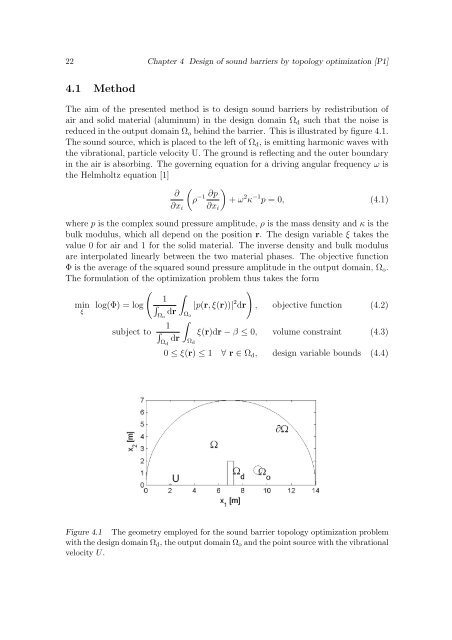Maria Bayard Dühring - Solid Mechanics
Maria Bayard Dühring - Solid Mechanics
Maria Bayard Dühring - Solid Mechanics
You also want an ePaper? Increase the reach of your titles
YUMPU automatically turns print PDFs into web optimized ePapers that Google loves.
22 Chapter 4 Design of sound barriers by topology optimization [P1]<br />
4.1 Method<br />
The aim of the presented method is to design sound barriers by redistribution of<br />
air and solid material (aluminum) in the design domain Ωd such that the noise is<br />
reduced in the output domain Ωo behind the barrier. This is illustrated by figure 4.1.<br />
The sound source, which is placed to the left of Ωd, is emitting harmonic waves with<br />
the vibrational, particle velocity U. The ground is reflecting and the outer boundary<br />
in the air is absorbing. The governing equation for a driving angular frequency ω is<br />
the Helmholtz equation [1]<br />
∂<br />
∂xi<br />
<br />
−1 ∂p<br />
ρ + ω<br />
∂xi<br />
2 κ −1 p = 0, (4.1)<br />
where p is the complex sound pressure amplitude, ρ is the mass density and κ is the<br />
bulk modulus, which all depend on the position r. The design variable ξ takes the<br />
value 0 for air and 1 for the solid material. The inverse density and bulk modulus<br />
are interpolated linearly between the two material phases. The objective function<br />
Φ is the average of the squared sound pressure amplitude in the output domain, Ωo.<br />
The formulation of the optimization problem thus takes the form<br />
<br />
1<br />
min log(Φ) = log <br />
ξ<br />
Ωo dr<br />
<br />
|p(r, ξ(r))|<br />
Ωo<br />
2 <br />
dr , objective function (4.2)<br />
1<br />
subject to <br />
Ωd dr<br />
<br />
ξ(r)dr − β ≤ 0, volume constraint (4.3)<br />
Ωd<br />
0 ≤ ξ(r) ≤ 1 ∀ r ∈ Ωd, design variable bounds (4.4)<br />
Figure 4.1 The geometry employed for the sound barrier topology optimization problem<br />
with the design domain Ωd, the output domain Ωo and the point source with the vibrational<br />
velocity U.
















